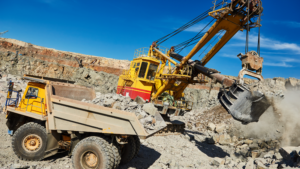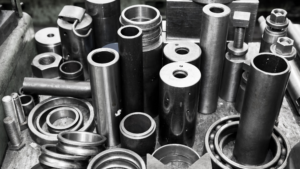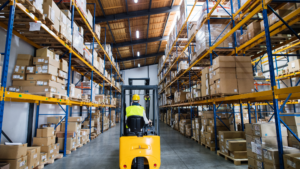If you work in or around any industry that deals with steel, you may have felt the collective shudder as steel prices have risen steadily and painfully over the past several months. 2020 saw record breaking highs in steel prices and Q1 of 2021 has shown only the slightest signs of slowing. What is happening to steel prices in Ontario and why? And sweet mercy, what can those affected do about it?
Are Steel Prices Going Up? Why?

You may have asked this question and gotten an apathetic generalization, distilled down just a couple words: The Pandemic. While that seems self-explanatory on the surface, the complex ecosystem of supply and demand, coupled with the massive upheavals of day-to-day operations in the supply chain, mean that the actual reason for skyrocketing steel prices is a bit more nuanced.
As a company building Racking Systems in Canada, we know that steel prices have a layered effect on our industry. Here’s some of the reasons why the prices are as high as they are, and a few creative ways to deal with it.
Supply Chain Interruptions Due To Changes In Production

The classic “supply and demand” principles in this situation get a little skewed when we confront the intersection of international supply chains amidst a global pandemic. While some international suppliers, such as China, are locking down to stop the spread of COVID-19, other countries are still operating. The ripple of lockdowns pops up in waves across the globe at different times, which creates an inconsistent supply chain with continuous stop-and-starts.
When international suppliers and manufactures have inconsistent production, demand turns to local supply, which is then quickly overwhelmed- driving demade (and thus, costs) up.
Demand For Steel Is Increasing Lead Time And Prices

When demand for steel is high, any producer with steel to spare is wise to put that steel out on the market. Struggling to meet increased demand, reserves of steel and iron ore are depleted faster than normal without supplies being restored. The effect? Additional lead times to allow for replenishment of supplies and time to complete orders.
As an example, members of OSSFA (Ontario Structural Steel Fabricators Association) were recently notified in a letter to the editor of Daily Commercial News that the historic rise in material pricing of structural steel was leading to increased lead times.
Billet Steel (the blocks of metal used for melting) have had a previous lead time of 2-3 weeks from order time. The supply chain changes have caused a lead time to jump to 6-8 weeks with little to no guarantee that the steel mill will receive your order for process within 30 days.
Previous timeline guarantees are no longer viable. Taxed by a lack of access to raw materials, Steel manufacturers have to shift timelines and adjust guarantees, since the previously accepted standards can no longer be adhered to.
Longer lead times, lack of access to raw materials and the increased time and resources now required for international shipping and receiving, mean that the industry is struggling to remain streamline during the unstable ground it is working on.
Iron Ore Prices Are Rising

Iron ore prices are rising. When raw material prices increase, that cost snowballs down through all aspects of production. Additional cost in Iron ore means higher processing costs, increased shipping costs, of course, international shipping, handling and customs fees. Even when the industry saw earlier shipping in post-Holiday orders, the demand for raw materials and the cost associated with them continued to rise.
At the time of this article, March 2021, there has been only a faint hint of prices plateauing, and the concern of prices rising continues.
Okay, So What Can We Do About Rising Steel Prices?

We have good news and bad news. Let’s stick with the bad news first.
For the immediate future, there isn’t much we can do about rising steel prices. As long as supply chains remain inconsistent, as long as various points across the world are shutting down off-and-on to control the global Pandemic, and as long as reserves of Steel and Iron ore remain depleted below industry confidence, prices are likely to increase, or at least- remain high.
Sorry- we know that sucks.
But don’t worry- we have some good news too.
There might not be ways to bring the cost of steel down for your or your company at this moment, but there are ways you can reduce your need for steel.
As a Racking company, with years of experience in racking Installation and racking systems, we can provide you some tips specifically geared around your warehouse needs. If you run or manage a warehouse, you may want to consider some of the following ways you can reduce your steel needs for your Warehouse.
Consider A Warehouse Tear-Down And Revamp

The pandemic has had sweeping effects across all industries. For some, this means an increase in products on shelves, but for many others, it means a decrease. The decrease may be due to lower sales, but it also may be due to increased demand, and faster product turn over. In either case it may be time to reconsider your Warehouses’ racking needs.
Re-evaluating your Warehouse might indicate room for changes that can increase efficiency, productivity and reduce costs. More efficient racking systems may actually decrease the need for a certain amount of racking, or you may need less racking than you think.
VNA, also known as Very Narrow Aisle, are a specific type of Racking System designed for limited spaces. It takes up roughly half the required surface area of conventional racking systems. It can be installed with straight or angled arms and is a highly adaptable racking system solution. If your product is well suited to this design, then installing Very Narrow Aisles may reduce your racking needs without requiring you to expand your warehouse, or build additional traditional racking.
VNA may be a great solution for space saving Racking Systems, but it is not the only solution for reduction in your Warehouse. Consider contacting a Racking Company (We know a good one) that can provide site-consultations and workflow process reviews. A Warehouse Racking specialist can provide consultation on the most effective and efficient solutions to your warehouse and the racking best suited for your production needs.
The main advantage here is designing the most space-saving and efficient use of your racking system possible.
What’s The Advantage To Redesigning My Warehouse Racking Systems During A Steel Crisis?
The answer is two-fold: first, by creating a more efficient racking system, you reduce your need for steel, which in turn reduces your need for steel when it comes to install, repair or replace parts of your system.
The second factor is buy back. When you tear down your current racking system, and replace it (in part or in full) with a more efficient system, you have the option to sell your unused system.
In this situation, the rising steel prices may actually be a benefit to you, as you may be able to sell your steel racking used without offering a below-cost discount, as long as your racking is safe, and undamaged.
One Cause For Hope!

In these turbulent times, it is easy to become discouraged, but the old adage must not be forgotten: necessity is the mother of invention.
While it might seem overly hopeful to put trust in techno-optimism, it is not beyond the realm of reason to think that humanity may innovate its way out of dependency on steel. We are a fundamentally innovative species, and many of our most incredible inventions have been created out of the need to produce something more efficient than the technology that preceded it.
In fact, a recent report in the Good News Network highlighted a Stanford Designer who is producing exceptionally durable, non-toxic, biodegradable, waterproof, fire resistant bricks, that are stronger than concrete- being made out of mushroom fibers. It might be a way off from steel, but take heart. The time between now, and the next great industrial revolution may be closer than you think.
Inspired To Revamp Your Warehouse To A More Efficient Set-Up?
We are so happy to hear that! Racked Out would love to help. You can call us anytime, for a free Warehouse inspection, or quote! Let us rack your world!
https://www.thefabricator.com/thefabricator/blog/metalsmaterials/steel-price-increases-losing-steam
https://www.goodnewsnetwork.org/phil-ross-invents-mycelium-mushroom-bricks-arch/
https://www.globaltimes.cn/page/202102/1216327.shtml